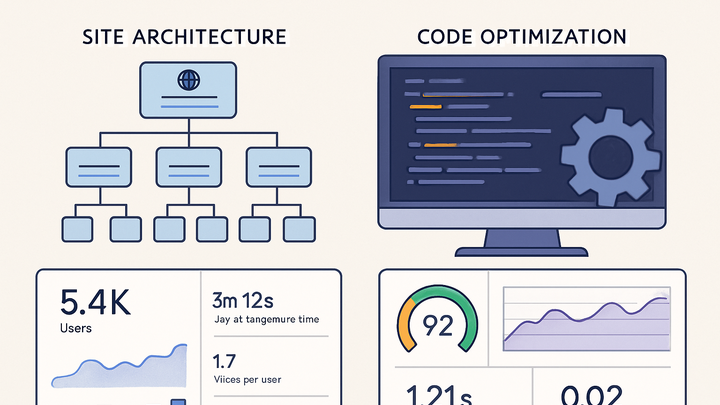Published on 2025-06-26T04:42:23Z
What is Technical SEO? Examples for Technical SEO
Technical SEO refers to the process of optimizing a website’s technical infrastructure to ensure search engines can crawl, index, and interpret the content effectively. It encompasses a broad range of activities including site speed optimization, mobile-friendliness, secure connections (HTTPS), structured data implementation, and proper use of robots.txt and sitemaps. In the analytics industry, Technical SEO plays a pivotal role in ensuring that data collected by tools like GA4 and PlainSignal is accurate and comprehensive.
For example, a slow-loading page can lead to high bounce rates and incomplete data capture, skewing performance metrics. Similarly, misconfigured robots.txt or missing XML sitemaps can prevent search engines from discovering certain pages, impacting both search visibility and traffic analytics. By leveraging advanced analytics platforms, teams can monitor key technical KPIs—such as Core Web Vitals in GA4 or real-time performance metrics in PlainSignal—to identify issues and measure the impact of technical optimizations.
Below, you’ll find a deep dive into the core components of Technical SEO, practical examples using GA4 and PlainSignal, and best practices for auditing and continuous improvement.
Technical seo
Technical SEO is optimizing a site's technical aspects like speed, crawlability, and schema to improve search visibility and analytics accuracy.
Why Technical SEO Matters
Technical SEO ensures that search engines and analytics tools can effectively discover, crawl, and index your site, leading to better visibility, user experience, and data accuracy. Poor technical foundations can result in incomplete analytics data, misinterpretation of user behavior, and lost search traffic.
-
Improved crawlability
By optimizing site structure and robots directives, you ensure search engine bots can access and index all important content.
-
Robots.txt configuration
Define which files and directories search engines can crawl to prevent accidental blocking of key pages.
-
Proper use of xml sitemaps
Maintain up-to-date sitemaps to guide search engines to new or updated pages.
-
-
Faster loading times
Minimizing resource sizes, leveraging CDNs, and optimizing server response times improve page speed, a critical ranking factor and user experience metric.
-
Image compression
Use modern formats like WebP and lazy-loading to reduce load times.
-
Content delivery networks
Distribute assets geographically to decrease latency.
-
-
Secure https implementation
Migrating to HTTPS not only protects user data but is also a trust signal for both users and search engines.
-
Ssl certificate
Ensure certificates are valid and renewed to prevent security warnings.
-
Mixed content resolution
Fix HTTP resources on HTTPS pages to avoid browser security errors.
-
Core Components of Technical SEO
The pillars of Technical SEO cover various on-site configurations and protocols that collectively improve site health, performance, and discoverability.
-
Site architecture
A logical and hierarchical structure helps both users and bots navigate the site effectively.
-
Silo structuring
Group related content under thematic sections to establish topical authority.
-
Internal linking
Strategically link pages to distribute link equity and guide crawlers.
-
-
Mobile optimization
With mobile-first indexing, sites must be responsive and perform well on mobile devices to rank effectively.
-
Responsive design
Use fluid layouts and CSS media queries for various screen sizes.
-
Mobile-friendly testing
Leverage Google’s Mobile-Friendly Test to identify issues.
-
-
Structured data and schema markup
Implementing schema enhances rich results, improving click-through rates and providing more context to search engines.
-
Json-ld format
Embed structured data in the head section using JSON-LD for easier maintenance.
-
Common schemas
Use schema.org types like Article, Product, BreadcrumbList for relevant content.
-
-
Canonical tags
Prevent duplicate content issues by specifying the preferred URL version of a page.
-
Self-referencing canonicals
Each page should include a canonical tag pointing to itself.
-
Parameter handling
Canonicalize pages to the cleanest URL when tracking or filtering parameters are present.
-
Leveraging Analytics Tools for Technical SEO
Analytics platforms like GA4 and PlainSignal provide insights into technical performance, allowing teams to correlate technical health with user behavior and SEO outcomes.
-
Monitoring core web vitals
Track LCP, FID, and CLS to evaluate page experience and identify performance bottlenecks.
-
GA4 integration
Enable Web Vitals reports to view performance metrics across pages.
-
PlainSignal dashboards
Use PlainSignal’s real-time metrics to detect anomalies in loading times.
-
-
Crawl error analysis
Identify and resolve 4xx/5xx errors that can hinder search engine indexing and impact analytics accuracy.
-
Search console reports
Use the Crawl Errors report to spot broken links and server issues.
-
GA4 event tracking
Set up custom events to capture and alert on page load failures.
-
-
Performance tracking with PlainSignal
Implement PlainSignal’s simple, cookie-free analytics to monitor page performance without sacrificing privacy.
-
Installation code
<link rel="preconnect" href="//eu.plainsignal.com/" crossorigin /> <script defer data-do="yourwebsitedomain.com" data-id="0GQV1xmtzQQ" data-api="//eu.plainsignal.com" src="//cdn.plainsignal.com/plainsignal-min.js"></script> -
Real-time insights
Capture performance metrics instantly through PlainSignal’s dashboard for proactive optimization.
-
Best Practices and Auditing
Regular audits and automated monitoring ensure that technical SEO issues are caught early, maintaining site health and consistent analytics reliability.
-
Regular site audits
Use tools like Lighthouse, Screaming Frog, and GA4 reports to perform comprehensive site health checks.
-
Lighthouse audits
Run performance, accessibility, SEO, and best practice audits directly in Chrome DevTools.
-
Screaming frog crawls
Identify broken links, duplicate content, and missing metadata at scale.
-
-
Automated monitoring and alerts
Set up alerts to notify teams of critical technical issues before they escalate.
-
GA4 custom alerts
Configure thresholds for significant drops in pageviews or spikes in load times.
-
Webhook notifications
Integrate PlainSignal’s real-time alerts with Slack or email for immediate action.
-
-
Continuous optimization
Adopt an iterative approach to test, measure, and refine technical SEO strategies over time.
-
A/b testing
Evaluate the impact of code optimizations and technology changes on user behavior.
-
Documentation and workflows
Maintain clear records of changes and establish processes for ongoing updates.
-
